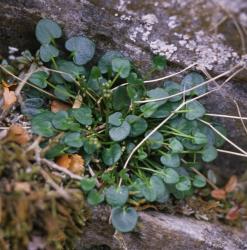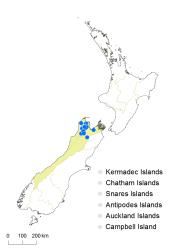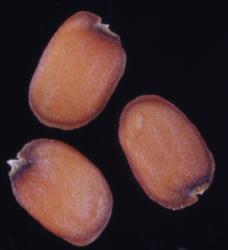Perennial herb, single rosette or with short lateral branches, stem and branches 1.0–1.6 mm diam. Leaves up to 95 mm long, simple or pinnatisect; lamina 2.0–38.0 × 2.0–16.5 mm, glossy, dark green, rarely purple-brown, glabrous or rarely sparsely hairy, coriaceous. Terminal pinna 2.0–15.0 × 2.0–16.5 mm, orbicular-reniform to deltoid-reniform, margin entire or with 2 lateral hydathodes, apex obtuse and entire or with a distinct hydathode; base usually strongly cordate, sometimes ± truncate. Lateral pinnae 1–4 or absent, 1.0–5.0 × 1.0–6.5 mm, orbicular to broadly orbicular, sessile or petiolule up to 1.0 mm long; petiole up to 80 mm long, plano-convex, glabrous. Cauline leaves often subtending lower pedicels, elliptic to linear-lanceolate, smaller, with fewer lateral pinnae than rosette leaves; upper leaves 5.0–10.0 × 2.0–3.5 mm, pinna increasingly linear, pinnatisect, pinnatifid or simple, glabrous or rarely sparsely hairy. Inflorescence racemose, with 1–3 lateral racemes, each raceme 2–12-flowered and often with scattered flowers lower down the peduncle, flowers occasionally solitary; peduncle up to 250 mm long, 0.5–1.5 mm diam. at base, spreading to ascending, glabrous. Pedicels 6.0–30.0(–50) mm long, 0.3–0.7 mm diam., glabrous. Sepals 1.8–3.3 × 0.9–1.5 mm, elliptic-oblong to broadly elliptic, ± saccate, green and sometimes flushed red-brown, glabrous or sparsely hairy, hairs 0.4–0.7 mm long; margin white and membranous, apex obtuse, base truncate. Petals 4.8–8.0 × 2.2–4.6 mm, white, limb obovate to broadly obovate; apex obtuse; base cuneate, tapering to a 1.0–1.5 mm long claw. Stamens 6; median filaments 4, 2.7–4.0 mm long; lateral filaments 2, 2.2–3.3 mm long; anthers 0.5–0.8 mm long, maroon or cream to pale yellow, when dehiscent held at a similar height to or slightly below the stigma. Ovary 3.2–4.0 mm long, 0.4–0.6 mm diam., ± terete, green, glabrous; ovules 26–32; style 0.2–1.0 mm long, ± terete; stigma 0.4–0.6 mm diam. Siliques 11.0–36.0 × 1.0–1.7 mm, glabrous, style 0.5–3.3 mm long; valves green or red-brown at maturity; straw-coloured when dehiscent, replum 0.4–0.5 mm wide. Seeds 0.9–1.3 mm long, 0.7–0.9 mm wide, 0.3–0.4 mm thick, orbicular to oblong, yellow-brown to henna; wing absent.
South Island: Western Nelson, Sounds Nelson, Westland.
Cardamine basicola most commonly grows on shaded crevices and ledges on limestone and marble cliffs and rock outcrops in forest and open habitats, and less commonly on conglomerate boulders, grassland, and scree. On Dun Mountain (north-eastern Nelson) C. basicola occurs on ultramafic soils, where it grows in shaded and/or moist crevices and overhangs among rock outcrops and bluffs; in open, sparsely vegetated areas among Chionochloa defracta where there is good soil moisture; and in forest.
Cardamine basicola is assessed as having a conservation status of Not Threatened (de Lange et al. 2018).
Flowering December–April; Fruiting January–May.
Previously known by the tagname C. "calcicole".






